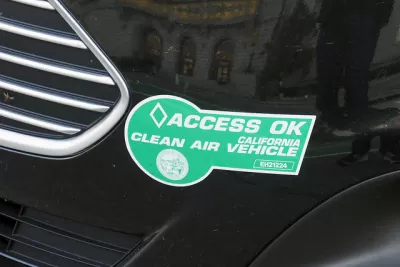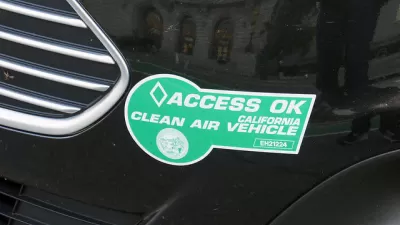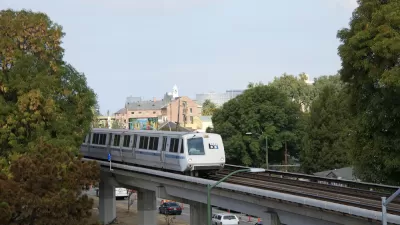As many as 215,000 owners of mostly electric vehicles purchased before 2017 lost their privilege to access carpool lanes on New Year's Day. The main purpose of HOV lanes is to reduce congestion.

Electric vehicle (EV) drivers whose clean air vehicle decals expired on on New Year's Day shouldn't blame Assemblymember Richard Bloom (D-Santa Monica), who authored Assembly Bill 544 for the loss of their privilege to access carpool lanes as solo drivers. All white and green decals expired due to legislation authored by then-Assemblymember Bob Blumenfield (D-Los Angeles) in 2013 under which they were issued.
For those motorists driving EVs and fuel cell electric vehicles purchased or leased in 2017 and later, they have Bloom to thank as it was his second attempt at ensuring that near-zero and zero-emission vehicles would retain solo-occupant vehicle access to the state's extensive network of high occupancy vehicle (HOV) lanes, and (mostly) toll-free use of the growing network of high occupancy toll (HOT) lanes, also called express lanes. Gov. Jerry Brown signed AB 544 in October 2017 as one of a dozen bills to increase adoption of zero-emission vehicles.
Decal update: In with red and purple, out with white and green
Owners and lessees of eligible battery-electric, fuel cell and natural-gas powered vehicles purchased prior to 2017 could purchase white clean air vehicle decals issued by the state Department of Motor Vehicles. They expired on Jan. 1, 2019, as did green decals for plug-in hybrid electric vehicles (PHEV), e.g., Chevy Volt, which also have internal combustion engines.
According to Randol White of Capital Public Radio, Sacramento's NPR affiliate, state officials estimate the number to be around 215,000 vehicles. (See/listen to source article.)
For vehicles with green and white decals purchased in 2017 and early 2018, owners can purchase a $22 red decal to replace the expired white or green decal, good for three years, expiring Jan. 1, 2022. These will go on all eligible vehicles: battery electrics, fuel cells, and PHEVs, and natural gas, if there are any (Honda stopped making their GX, but perhaps conversions are eligible). Last March, the Department of Motor Vehicles began issuing red decals, reported Rachel Swan of the San Francisco Chronicle in an extensive article on all the changes to the clean air vehicle program.
Clean air vehicles purchased this year qualify for a 4-year purple sticker, valid till Jan. 1, 2023.
The four-year decal applies for eligible vehicles for future model years, using potentially different colors, but the federal program allowing carpool access for clean vehicles expires on 2025.
If you have a white or green decal, check the descriptions of the decal program on the California Air Resources Board and/or Department of Motor Vehicles webpages for further clarification.
Used EV market to gain access to HOV lane
"Can I buy a used vehicle that had an expired or expiring sticker and get red stickers on it?" That's question #11 in Swan's FAQ piece on the decal program.
Starting in 2020, yes — but only if your household income falls below 80 percent of the state median. In 2016, California’s median household income was $63,783, according to the U.S. Census Bureau, and 80 percent of that is about $51,000.
Conflicting uses for carpool lanes
As initially posted last September, the increasing presence of solo-occupant electric vehicles created a conflict for the original purpose of carpool lanes, which need to operate at a minimum of 45 mph to meet federal standards. In 2016, California’s highways met that benchmark only 32% of the time, according to Caltrans data, reported Laura Newberry for the Los Angeles Times.
Additional media coverage by Green Car Congress: California white and green carpool stickers expire New Year's Day.
-
220,000 EV Drivers in California to Lose Carpool Lane Perk in 2019, September 21, 2018
-
Electric Vehicles to Lose Important Perk in Southern California, April 30, 2018 [This post is not about expiring clean air vehicle decals].
FULL STORY: More Than 200,000 Clean Cars Will Lose California HOV Access In 2019

Alabama: Trump Terminates Settlements for Black Communities Harmed By Raw Sewage
Trump deemed the landmark civil rights agreement “illegal DEI and environmental justice policy.”

Study: Maui’s Plan to Convert Vacation Rentals to Long-Term Housing Could Cause Nearly $1 Billion Economic Loss
The plan would reduce visitor accommodation by 25% resulting in 1,900 jobs lost.

Planetizen Federal Action Tracker
A weekly monitor of how Trump’s orders and actions are impacting planners and planning in America.

Wind Energy on the Rise Despite Federal Policy Reversal
The Trump administration is revoking federal support for renewable energy, but demand for new projects continues unabated.

Passengers Flock to Caltrain After Electrification
The new electric trains are running faster and more reliably, leading to strong ridership growth on the Bay Area rail system.

Texas Churches Rally Behind ‘Yes in God’s Back Yard’ Legislation
Religious leaders want the state to reduce zoning regulations to streamline leasing church-owned land to housing developers.
Urban Design for Planners 1: Software Tools
This six-course series explores essential urban design concepts using open source software and equips planners with the tools they need to participate fully in the urban design process.
Planning for Universal Design
Learn the tools for implementing Universal Design in planning regulations.
Caltrans
Smith Gee Studio
Institute for Housing and Urban Development Studies (IHS)
City of Grandview
Harvard GSD Executive Education
Toledo-Lucas County Plan Commissions
Salt Lake City
NYU Wagner Graduate School of Public Service




























